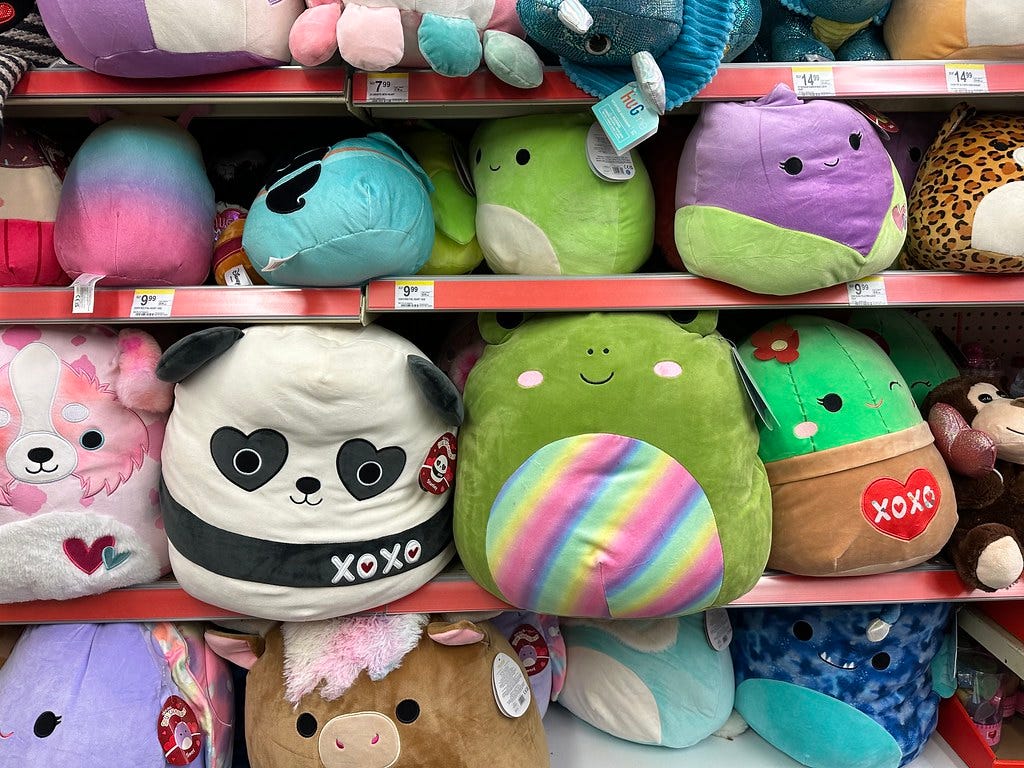The Remarkable Growth of Funko Pops & Squishmallows
Taking Inspiration from Two Toy Industry Brands' Success to Drive Consumer Engagement and Innovation

As the global toy industry continues to flourish, expanding from $90 billion in 2018 to an estimated $120 billion in 2023, understanding consumer preferences and leveraging pop culture trends is critical to staying ahead of the curve.
The remarkable growth of Funko Pops and Squishmallows, two seemingly different products, offers invaluable insights for retailers, manufacturers, brands, and businesses.
Funko Pops, known for their distinctive vinyl figures of pop culture characters, and Squishmallows, a line of plush toys with unique personalities and backstories, have seen remarkable growth in recent years.
This article will explore the factors driving their popularity and discuss the implications and opportunities for stakeholders in the ever-growing toy industry.
Background
Funko Pop reported a significant global sales increase driven by sustained fan demand. US net sales increased by 70.1% year-over-year in the first quarter of 2022. In the third quarter of 2022, Funko achieved record sales, with net sales increasing by 36.6% to $365.6 million.
Squishmallows, plush toys produced by Kellytoy LLC, first hit the market in 2017 and gained notable popularity in 2020. Between Feb 2020 and Oct 2021, the company sold 50 million Squishmallows, bringing the total number to over 100 million.
Overview of Insights
The success of Funko Pops and Squishmallows can be attributed to several factors, including their ability to foster communities, nostalgia and pop culture appeal, collectibility and exclusivity, emotional connection, social media influence, diverse demographics, and cross-category collaborations.
These insights can help stakeholders understand the driving forces behind consumer preferences and guide decision-making in the toy industry.
1. Nostalgia and Pop Culture Appeal
Funko Pops and Squishmallows often feature characters from popular movies, TV shows, video games, and other pop culture phenomena. Consumers are drawn to products that tap into their nostalgia and interests, making it essential for brands to stay in tune with current trends.
2. Collectibility and Exclusivity
Many Funko Pops and Squishmallows are released in limited editions, making them highly sought after by collectors. These products collectibility and perceived exclusivity drive demand and create secondary markets where rare items are sold at a premium on marketplaces like eBay.
3. Emotional Connection
Squishmallows, in particular, are known for their soft and cuddly texture; each character has a unique backstory. This highlights the importance of creating an emotional connection with consumers, who may view these products as comforting or a way to express their personality.
4. Social Media Influence
The popularity of both Funko Pops and Squishmallows has been amplified through social media platforms such as TikTok, Instagram, and YouTube. Unboxing videos, hauls, and collections shared by influencers and fans contribute to the virality and hype surrounding these products.
By actively engaging with fans, soliciting feedback, organizing events, and creating spaces for consumers to connect and share their passion for the products, brands can foster a sense of community around their offerings.
5. Diverse Demographics
While toys are traditionally associated with children, Funko Pops and Squishmallows appeal to a wide range of age groups, including adults. This suggests that toy companies can expand their target audience by offering products that resonate with consumers of all ages.
6. Cross-Category Collaborations
The popularity of these products has led to cross-category collaborations, such as Squishmallows appearing in virtual games like Roblox or Funko producing merchandise beyond vinyl figures (e.g., apparel and accessories). This indicates the potential for successful brands to expand into new markets and product categories.
Strategic Insights and Recommendations for Retailers, Manufacturers, Brands, and Businesses
Drawing inspiration from the success of Funko Pops and Squishmallows, businesses and brands can adapt their product strategies to align with consumer preferences and capitalize on emerging trends:
Conduct regular market research: Stay attuned to pop culture trends and consumer preferences to develop products that resonate with popular culture, create lasting appeal, and drive sales.
Generate buzz with exclusivity: Leverage collectibility by introducing limited-edition products or exclusive collaborations to increase product value and entice collectors.
Foster emotional connections: Enhance consumer engagement and loyalty by designing products with unique features or engaging backstories that create emotional connections and improve the customer experience.
Utilize social media for visibility: Implement effective social media marketing strategies on platforms like TikTok, Instagram, and YouTube to boost product exposure, engage with fans, and foster a sense of community around the brand.
Cater to diverse demographics and nurture communities: Offer products that appeal to a wide range of age groups, including both children and adults, to expand the target audience and tap into unexplored markets. Actively engage with fans, solicit feedback, organize events, and create spaces for consumers to connect and share their passion for your products.
Explore cross-category collaborations and new markets: Collaborate with other brands, franchises, or product categories to create new opportunities, diversify offerings, and expand the brand's reach. Forge partnerships and develop innovative cross-category products to explore new opportunities and markets, further expanding brand reach and diversifying offerings.
Opportunities & Growth
The remarkable success of Funko Pops and Squishmallows demonstrates the power of tapping into consumer preferences and pop culture trends and fostering emotional connections with customers.
By drawing inspiration from these success stories, retailers, manufacturers, brands, and businesses can develop product strategies that resonate with diverse demographics, engage audiences on social media, and create a strong sense of community among fans.
Adapting to these insights can help industry stakeholders stay ahead of the curve in the ever-growing toy market and unlock new opportunities for growth and innovation.
Quy Ma is a Category Management, Customer Insights, & Market Research Expert. With over 13 years of experience managing categories across different industries, he’s helped brands find solutions by developing innovative new products & programs. He’s passionate about empowering small businesses, connecting them with the right customers, and maximizing the customer experience.




